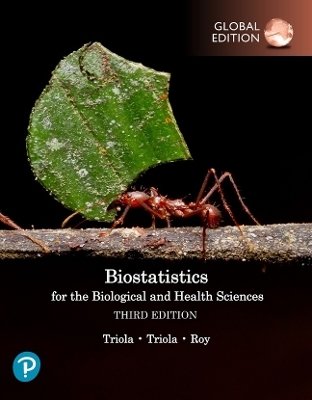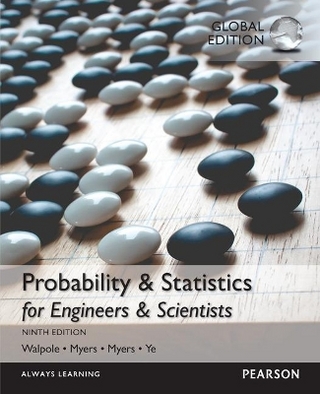
Mind on Statistics
Brooks/Cole
978-0-495-11862-6 (ISBN)
- Keine Verlagsinformationen verfügbar
- Artikel merken
MIND ON STATISTICS emphasizes the conceptual development of statistical ideas and seeks to find meaning in data. Authors Jessica Utts and Robert Heckard satisfy students' natural curiosity by actively engaging them with inspiring questions and explaining statistical topics in the context of excellent examples and case studies. MIND ON STATISTICS balances the spirit of statistical literacy with the statistical methodology taught in general introductory statistics courses. The authors built the book on two learning premises: (1) New material is much easier to learn and remember if it is related to something interesting or previously known; (2) New material is easier to learn if students actively ask questions and find the answers for themselves. More than any other text available, MIND ON STATISTICS motivates students to develop their statistical intuition by focusing on analyzing data and interpreting results, rather than on mathematical formulation. A wide range of interesting and real examples provides further motivation for students to learn about statistics.
1. STATISTICS SUCCESS STORIES AND CAUTIONARY TALES. What is Statistics? Seven Statistical Stories with Morals. Case Study 1.1: Who Are Those Speedy Drivers? Case Study 1.2: Safety in the Skies. Case Study 1.3: Did Anyone Ask You Whom You've Been Dating? Case Study 1.4: Who Are Those Angry Women? Case Study 1.5: Does Prayer Lower Blood Pressure? Case Study 1.6: Does Aspirin Reduce Heart Attack Rates? Case Study 1.7: Does the Internet Increase Loneliness and Depression? The Common Elements of the Seven Stories. 2. TURNING DATA INTO INFORMATION. Raw Data. Types of Variables. Summarizing One or Two Categorical Variables. Exploring Features of Quantitatve Data with Pictures. Numerical Summaries of Quantitative Variables. How to Handle Outliers. Features of Bell-Shaped Distributions. Skillbuilder Applet: The Empirical Rule in Action. 3. SAMPLING: SURVEYS AND HOW TO ASK QUESTIONS. Collecting and Using Sample Data Wisely. Margin of Error, Confidence Intervals, and Sample Size. Choosing a Simple Random Sample. Other Sampling Methods. Difficulties and Disasters in Sampling. Case Study 3.1: The Infamous Literary Digest Poll of 1936. How to Ask Survey Questions. Case Study 3.2: No Opinion of Your Own? Let Politics Decide. Skillbuilder Applet: Random Sampling in Action. 4. GATHERING USEFUL DATA FOR EXAMINING RELATIONSHIPS. Speaking the Language of Research Studies. Case Study 4.1: Lead Exposure and Bad Teeth. Designing a Good Experiment. Case Study 4.2: Kids and Weight Lifting. Case Study 4.3: Quitting Smoking with Nicotine Patches. Designing a Good Observational Study. Case Study 4.4: Baldness and Heart Attacks. Difficulties and Disasters in Experiments and Observational Studies. 5. RELATIONSHIPS BETWEEN QUANTITATIVE VARIABLES. Looking for Patterns with Scatterplots. Describing Linear Patterns with a Regression Line. Measuring Strength and Direction with Correlation. Regression and Correlation Difficulties and Disasters. Correlation Does Not Prove Causation. Skillbuilder Applet: Exploring Correlation. Case Study 5.1: A Weighty Issue. 6. RELATIONSHIPS BETWEEN CATEGORICAL VARIABLES. Displaying Relationships Between Categorical Variables. Risk, Relative Risks, and Misleading Statistics About Risk. Case Study 6.1: Is Smoking More Dangerous for Women? The Effect of a Third Variable and Simpson's Paradox. Assessing the Statistical Significance of a 2 x 2 Table. Case Study 6.2: Drinking, Driving, and the Supreme Court. 7. PROBABILITY. Random Circumstances. Case Study 7.1: A Hypothetical Story?Alicia Has a Bad Day. Interpretations of Probability. Probability Definitions and Relationships. Basic Rules for Finding Probabilities. Strategies for Finding Complicated Probabilities. Using Simulation to Estimate Probabilities. Coincidences and Intuitive Judgments About Probability. Case Study 7.2: Doin' the iPod Shuffle. 8. RANDOM VARIABLES. What is a Random Variable? Discrete Random Variables. Expectations for Random Variables. Binomial Random Variables. Case Study 8.1: Does Caffeine Enhance the Taste of Cola? Continuous Random Variables. Normal Random Variables. Approximating Binomial Distribution Probabilities. Sums, Differences, and Combinations of Random Variables. 9. UNDERSTANDING SAMPLING DISTRIBUTIONS: STATISTICS AS RANDOM VARIABLES. Parameters, Statistics, and Statistical Inference. From Curiosity to Questions About Parameters. SD Module 0: An Overview of Sampling Distributions. SD Module 1: Sampling Distribution for One Sample Proportion. SD Module 2: Sampling Distribution for the Difference in Two Sample Proportions. SD Module 3: Sampling Distribution for One Sample Mean. SD Module 4: Sampling Distribution for the Sample Mean of Paired Differences. SD Module 5: Sampling Distribution for the Difference in Two Sample Means. Preparing for Statistical Inference: Standardized Statistics. Lesson 1: Standardized Statistics for Sampling Distributions. Lesson 2: Standardized Statistics for Proportions. Lesson 3: Standardized Statistics for Means. Generalizations Beyond the Big Five. Skillbuilder Applet: Finding the Pattern in Sample Means. Case Study 9.1: Do Americans Really Vote When They Say They Do? Table: Summary of Sampling Distributions. 10. ESTIMATING PROPORTIONS WITH CONFIDENCE. Introduction. CI Module 0: An Overview of Confidence Intervals. Lesson 1: Understanding Confidence Intervals. Lesson 2: Computing Confidence Intervals for the Five Scenarios. CI Module 1: Confidence Interval for a Population Proportion. Lesson 1: Details of How to Compute a Confidence Interval for a Population Proportion. Lesson 2: Understanding the Formula. Lesson 3: Reconciling Margin of Error and 95% Confidence Intervals. CI Module 2: Confidence Intervals for the Difference in Two Population Proportions. Using Confidence Intervals to Guide Decisions. Case Study 10.1: Extrasensory Perception Works With Movies. Case Study 10.2: Nicotine Patches Versus Zyban. Case Study 10.3: What a Great Personality. 11. ESTIMATING MEANS WITH CONFIDENCE. Introduction to Confidence Intervals for Means. CI Module 3: Confidence Intervals for One Population Mean. Lesson 1: Finding a Confidence Interval for a Mean For Any Sample Size and Any Confidence Level. Lesson 2: Special Case: Approximate 95% Confidence Intervals for Large Samples. CI Module 4: Confidence Interval for the Population Mean of Paired Differences. CI Module 5: Confidence Interval for the Difference in Two Population Means. Lesson 1: The General (Unpooled) Case. Lesson 2: The Equal Variance Assumption and the Pooled Standard Error. Understanding Any Confidence Interval. Case Study 11.1: Confidence Interval for Relative Risk: Case Study 4.4 Revisited. Case Study 11.2: Premenstrual Syndrome? Try Calcium. Skillbuilder Applet: The Confidence Level in Action. Table: Summary of Confidence Interval Procedures. 12. TESTING HYPOTHESES ABOUT PROPORTIONS. Introduction. HT Module 0: An Overview of Hypothesis Testing. Lesson 1: Formulating Hypothesis Statements. Lesson 2: The Logic and Details of Hypothesis Testing. Lesson 3: What Can Go Wrong: The Two Types of Errors and Their Probabilities. HT Module 1: Testing Hypotheses about a Population Proportion. HT Module 2: Testing Hypotheses about the Difference in Two Population Proportions. Sample Size, Statistical Significance and Practical Importance. Case Study 12.1: The Internet and Loneliness: Case Study 1.7 Revisited. Case Study 12.2: An Interpretation of a p-Value Not Fit to Print. 13. TESTING HYPOTHESES ABOUT MEANS. Introduction to Hypothesis Tests for Means. HT Module 3: Testing Hypotheses about One Population Mean. HT Module 4: Testing Hypotheses about the Population Mean of Paired Differences. HT Module 5: Testing Hypotheses about the Difference in Two Population Means. Lesson 1: The General (Unpooled) Case. Lesson 2: The Pooled Two-Sample t-Test. The Relationship Between Significance Tests and Confidence Intervals. Choosing an Appropriate Inference Procedure. Effect Size. Evaluating Significance in Research Reports. Table: Summary of Hypothesis Testing Procedures. 14. INFERENCE ABOUT SIMPLE REGRESSION. Sample and Population Regression Models. Estimating the Standard Deviation for Regression. Inference About the Linear Regression Relationship. Predicting y and Estimating Mean y at a Specific X. Checking Conditions for Using Regression Models for Inference. Case Study 14.1: A Contested Election. 15. MORE INFERENCE ABOUT CATEGORICAL VARIABLES. The Chi-Square Test for Two-Way Tables. Analyzing 2 x 2 Tables. Testing Hypotheses About One Categorical Variable: Goodness of Fit. Case Study 15.1: Do You Mind if I Eat the Blue Ones? 16. ANALYSIS OF VARIANCE. Comparing Means with an ANOVA F-test. Details of One-Way Analysis of Variance. Other Methods for Comparing Populations. Two-Way Analysis of Variance. 17. TURNING INFORMATION INTO WISDOM. Beyond the Data. Transforming Uncertainty Into Wisdom. Making Personal Decisions. Control of Societal Risks. Understanding Our World. Getting to Know You. Words to the Wise. References. Appendix of Tables. Answers to Selected Exercises. Index. SUPPLEMENTAL TOPICS (APPEAR ON THE STUDENT SUITE CD-ROM ONLY). 1. ADDITIONAL DISCRETE RANDOM VARIABLES. Hypergeometric Distribution. Poisson Distribution. Multinomial Distribution. 2. NONPARAMETRIC TESTS OF HYPOTHESES. The Sign Test. The Two-Sample Rank-Sum Test. The Wilcoxon Signed-Rank Test. The Kruskal-Wallis Test. 3. MULTIPLE REGRESSION. The Multiple Linear Regression Model. Inference About Multiple Regression Models. Checking Conditions for Multiple Linear Regression. 4. TWO-WAY ANALYSIS OF VARIANCE. Assumptions and Models for Two-Way ANOVA. Testing for Main Effects and Interactions. 5. ETHICS. Ethical Treatment of Human and Animal Participants. Assurance of Quality Data. Appropriate Statistical Analysis. Fair Reporting of Results. Case Study S5.1: Science Fair Project or Fair Science Project.
| Erscheint lt. Verlag | 2.2.2006 |
|---|---|
| Verlagsort | CA |
| Sprache | englisch |
| Maße | 203 x 251 mm |
| Gewicht | 1407 g |
| Themenwelt | Mathematik / Informatik ► Mathematik ► Statistik |
| ISBN-10 | 0-495-11862-1 / 0495118621 |
| ISBN-13 | 978-0-495-11862-6 / 9780495118626 |
| Zustand | Neuware |
| Haben Sie eine Frage zum Produkt? |
aus dem Bereich

